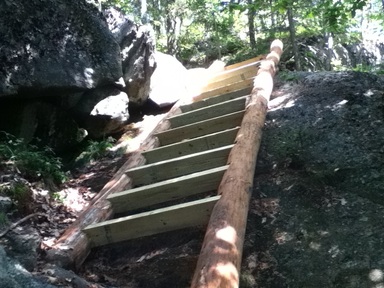
Conditions are dry and hot, about 90 degrees – in stark contrast to last month’s wet weather that had me slipping and sliding up and down the mountain. (Allow me to boast that I didn’t fall once today.) Turning off Route 124 into the parking area for the Old Toll Road, I notice a No Pipeline sign. This refers to a proposed natural gas pipeline that would transit rural communities from, according to nhpipelineawareness.org, “the fracking fields of PA to the gas hub in eastern MA.” The website paints a pretty dire picture – eminent domain takings, corporate hubris, exposure to accidents, lack of sustainability – but doesn’t once mention climate change, as in, hey, let’s leave the fossil fuels in the ground before we cook the world but good. Newsflash, as I write this: the National Oceanic and Atmospheric Administration announces that July, 2015 is the hottest month since the advent of record keeping in 1880.
And that’s no fluke – but I won’t bore you with stats. Numbers numb, say the communication honchos. Stories sell. Make ‘em cry, not think.
The curly-haired ranger who takes my fiver and gives me a map of Monadnock has a tiny nose stud and a friendly manner. “Any dogs?” she asks, peering into the backseat. I shake my head. Do people really smuggle them in? She directs me to park next to a Subaru with a Trees Not Towers, No Northern Pass bumper sticker. Everyone’s against something, I guess: mothers-in-law, light beer, income inequality, transmission lines on steel towers bringing hydroelectricity from Quebec. I can’t get behind this one much: if we environmentalists want to smack climate change in the mouth, we can’t object to every form of producing and transmitting renewable energy that offends our eyes or, in the e-lingo, “compromises pristine viewsheds.”
On the other hand, if those dread towers try to climb Monadnock…
And so, up the Old Toll Road. It’s mostly shaded, but my t-shirt gets soaked through in ten minutes. This sweaty male of the species takes a right onto the Parker Trail running east across the mountain, and the bugs make a coordinated attack. Liberal application of lotion works well except for the dive bombers buzzing my ears. I take an uphill left onto the Cliff Walk, marked by white C’s painted on rocks and plastic blazes nailed to tree trunks. The trail’s matted with aged oak leaves. After clambering up a log ladder, newly-hewn, I examine lacy moss, ivy, fungi and paint-box lichen. As if saying, hello mountain. Then I slap away, slap away, and finally kill a greenhead going for the vein on the back of my hand, and I feel bad about it. What a softie.
And that’s no fluke – but I won’t bore you with stats. Numbers numb, say the communication honchos. Stories sell. Make ‘em cry, not think.
The curly-haired ranger who takes my fiver and gives me a map of Monadnock has a tiny nose stud and a friendly manner. “Any dogs?” she asks, peering into the backseat. I shake my head. Do people really smuggle them in? She directs me to park next to a Subaru with a Trees Not Towers, No Northern Pass bumper sticker. Everyone’s against something, I guess: mothers-in-law, light beer, income inequality, transmission lines on steel towers bringing hydroelectricity from Quebec. I can’t get behind this one much: if we environmentalists want to smack climate change in the mouth, we can’t object to every form of producing and transmitting renewable energy that offends our eyes or, in the e-lingo, “compromises pristine viewsheds.”
On the other hand, if those dread towers try to climb Monadnock…
And so, up the Old Toll Road. It’s mostly shaded, but my t-shirt gets soaked through in ten minutes. This sweaty male of the species takes a right onto the Parker Trail running east across the mountain, and the bugs make a coordinated attack. Liberal application of lotion works well except for the dive bombers buzzing my ears. I take an uphill left onto the Cliff Walk, marked by white C’s painted on rocks and plastic blazes nailed to tree trunks. The trail’s matted with aged oak leaves. After clambering up a log ladder, newly-hewn, I examine lacy moss, ivy, fungi and paint-box lichen. As if saying, hello mountain. Then I slap away, slap away, and finally kill a greenhead going for the vein on the back of my hand, and I feel bad about it. What a softie.
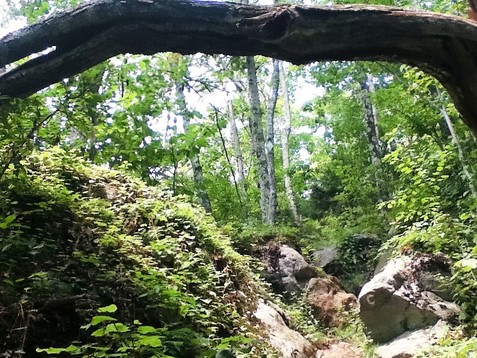
About 90 minutes in, I sit on a boulder with a fabulous view of green woods and retreating hills. There I munch a PB&J on stale challah bread, not bad, plus red grapes gone a bit sour. Bloated clouds plod across the sky. Hippos and ferry boats and wacky perpetual motion contraptions – those kinds of clouds, water-vapor barges plowing the Augusty day. I’m thinking about my 92-year-old mother and how, a few months ago, she lost the ability to walk more than several yards at a time, even with her walker. She gets out of breath easily and suffers from what she calls “jelly legs.” The worst part is that she refuses to be wheeled down to dinner – the crux of her social life – and is taking her meals alone in her apartment. A battery of tests and two new heart medications have made little difference. And I wonder if the change was as sudden as it seemed; perhaps hers was a gradual loss of strength that she'd been stoically fighting until, one creaky day, she fell back. She lost. My sisters think I should just accept my mother’s new status. Maybe they're right. Still, I’ve made a neurologist appointment for next month. A few more tests won’t kill her.
My bumper stick: Vitality Not Frailty. No to Debilitating Old Age.
The Cliff Walk takes a sharp right into thick pine woods. The trees’ lower branches have been snapped off by wind or fire or bears or G-d knows, and I pass a trailside boulder plush-carpeted in moss. Very sleek. Green globules of moss are scattered up and down the trail, as if spit by some monster with a bad summer cold – and there’s that bird call I’ve heard before, the hard, scraping skiiirrkk of the blue-bearded grumbler, or some such creature. A hundred yards more and I come to another stunning vista, this one on a ledge of rock protruding from the mountain. Here I’m completely exposed, beyond the treetops. From this spot I could be picked up by a swooping glider or one of Tolkien’s giant eagles. A helicopter could hover and drop a rescue rope. An alien spacecraft or NSA satellite might even mistake me for a mountain offering. I’m tempted, vaguely, to take a running leap and soar out, soar free, and fall parabolically…instead I just stand there and admire. The world is lush green, a hundred hues of green.
My bumper stick: Vitality Not Frailty. No to Debilitating Old Age.
The Cliff Walk takes a sharp right into thick pine woods. The trees’ lower branches have been snapped off by wind or fire or bears or G-d knows, and I pass a trailside boulder plush-carpeted in moss. Very sleek. Green globules of moss are scattered up and down the trail, as if spit by some monster with a bad summer cold – and there’s that bird call I’ve heard before, the hard, scraping skiiirrkk of the blue-bearded grumbler, or some such creature. A hundred yards more and I come to another stunning vista, this one on a ledge of rock protruding from the mountain. Here I’m completely exposed, beyond the treetops. From this spot I could be picked up by a swooping glider or one of Tolkien’s giant eagles. A helicopter could hover and drop a rescue rope. An alien spacecraft or NSA satellite might even mistake me for a mountain offering. I’m tempted, vaguely, to take a running leap and soar out, soar free, and fall parabolically…instead I just stand there and admire. The world is lush green, a hundred hues of green.
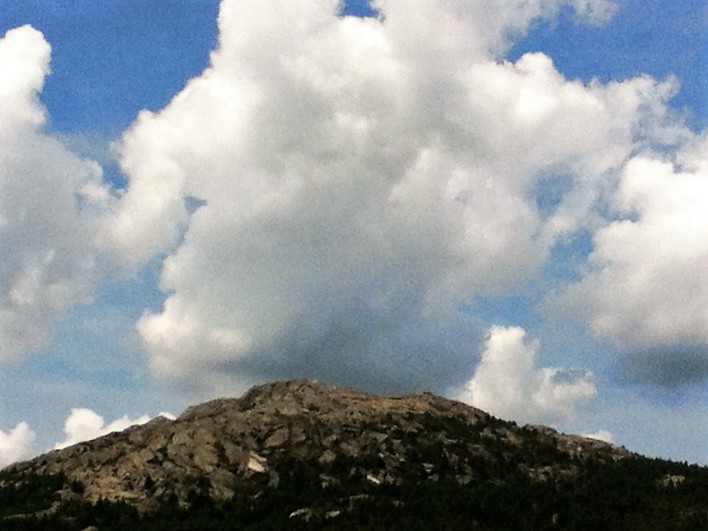
Going uphill again, I run into my first fellow hiker – if you can call him that. He’s on his way down, mid-20s, super-fit in trail-running shoes and going fast. On his back he holds – with both hands reaching back over his shoulders – what looks like a black pillow. I wave and ask him what he’s carrying. He releases one hand and flicks out his earbuds. It’s a 50-pound weight, explains this modern hod carrier. And why are you...? Seems he’s training for “alt-races” and doing it here is “way better than being in the gym all day.” I agree and comment on the day’s epic beauty and he agrees in turn. Then back go the earbuds and he bounds away before I can inquire, hey, wait, what’s an alt-race? That night, via The Google, I learn about alt-races such as ultra-running, for 100 miles or 24 hours straight; alleycatting, which mimics the crazy routes of bicycle messengers; and urban adventures featuring stair climbing, kayaking, extreme roller-skating and the catching in your mouth of oysters thrown from two stories up. I’m assuming they’re shelled.
I come to a large, bowl-shaped rock – Bald Rock. Here, too, is the famous place to plant your butt called Thoreau’s Seat. No evidence exists that Henry David Thoreau ever sat here, but he did come this way general way so you can’t prove he didn’t either. Absence of evidence is not evidence of absence, as my scientist wife is prone to say. Local lore has it that a Rhode Island industrialist named Scott A. Smith cooked up Thoreau’s Seat just for fun and vinegar. In his elderly years, around the start of the 20th century, the white-bearded, Monadnock-loving Smith spent his days telling wooly tales at the Halfway House inn on the western side of the mountain and blazing miles of secret trails for himself and his wealthy buddies. This kind of “trail development” summoned the wrath of the artist Abbot Thayer in nearby Dublin, who inveighed against “the killing of the goose that laid the golden egg.”
“Is the development of a tiger to cut off its claws and saw away his tremendous teeth?” ranted Thayer, who is best known for paintings of the mountain and of angels. He combined the two tropes in his wonderful Monadnock Angel (1919) which used to hang in the Harvard Art Museums until they renovated the place and devoted an entire floor to boring Rothko murals.
Around a bend – yes! – I catch a full-on view of the peak about a mile away. Ten months into my little hiking project and that first sighting continues to thrill. It gets me, like a sudden, glorious sunrise. Like a revelation. Today, on top of the mountain, a billowing, white-gray cloud seems to be balanced – angelically? Or, if you prefer, Monadnock is burping up a big one. Then the growling chirr of an airplane engine grows and from the west arrives a white prop plane that buzzes the summit, perhaps fifty yards above the tiny figures up there waving. The plane does a full 360 around them, waggles its wings, and sputters away. Blink and it could be 1936 and that’s an eccentric millionaire with his newfangled toy. Blink again and it’s 2015 and that’s an eccentric multi-millionaire with his antique toy.
I come to a large, bowl-shaped rock – Bald Rock. Here, too, is the famous place to plant your butt called Thoreau’s Seat. No evidence exists that Henry David Thoreau ever sat here, but he did come this way general way so you can’t prove he didn’t either. Absence of evidence is not evidence of absence, as my scientist wife is prone to say. Local lore has it that a Rhode Island industrialist named Scott A. Smith cooked up Thoreau’s Seat just for fun and vinegar. In his elderly years, around the start of the 20th century, the white-bearded, Monadnock-loving Smith spent his days telling wooly tales at the Halfway House inn on the western side of the mountain and blazing miles of secret trails for himself and his wealthy buddies. This kind of “trail development” summoned the wrath of the artist Abbot Thayer in nearby Dublin, who inveighed against “the killing of the goose that laid the golden egg.”
“Is the development of a tiger to cut off its claws and saw away his tremendous teeth?” ranted Thayer, who is best known for paintings of the mountain and of angels. He combined the two tropes in his wonderful Monadnock Angel (1919) which used to hang in the Harvard Art Museums until they renovated the place and devoted an entire floor to boring Rothko murals.
Around a bend – yes! – I catch a full-on view of the peak about a mile away. Ten months into my little hiking project and that first sighting continues to thrill. It gets me, like a sudden, glorious sunrise. Like a revelation. Today, on top of the mountain, a billowing, white-gray cloud seems to be balanced – angelically? Or, if you prefer, Monadnock is burping up a big one. Then the growling chirr of an airplane engine grows and from the west arrives a white prop plane that buzzes the summit, perhaps fifty yards above the tiny figures up there waving. The plane does a full 360 around them, waggles its wings, and sputters away. Blink and it could be 1936 and that’s an eccentric millionaire with his newfangled toy. Blink again and it’s 2015 and that’s an eccentric multi-millionaire with his antique toy.
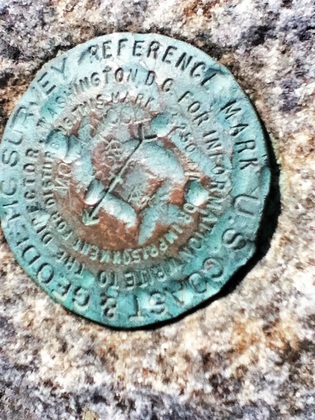
I forge ahead, trail to trail, bisecting the tree line: Cliff Walk to Smith Connecting to Amphitheater to White Arrow. I recall this last trail from a winter ascent; in fact, that climb was easier with the snow filling in crevices between rocks. Fifty yards short of the peak, I stop and chat with three twenty-somethings. The two guys are Boy Scout leaders and tell me about bringing kids up here in January, in below-zero weather. No problem, they joke, except for the exposed fingers snapping off. The third hiker, a thin young woman, suddenly and for no apparent reason teases one of the guys about the Oreo crumbs in his teeth. “I wait to the top to eat my Oreos,” I interject, and the victim of this teasing, who’s a bit portly, feigns a dizzy spell. “I couldn’t see,” he says, perhaps referring to the medicinal qualities of the cookie sandwich. At the peak, a few minutes later, the Scout leaders pick up tiny scraps of litter.
As usual, I tap my hiking stick on the summit plaque. Made it! Again! I check out the magnificent view, a wraparound spectacle of blue sky, gonzo clouds and forests rolling to faraway mountains. The sun glares down, the air is hot but roiled by a cooling wind. Then, for the first time, I make an inventory of these engraved, summit medallions. All four are grafted flush into the granite within twenty yards of each other. Three of them are labeled U.S. Coast and Geodetic Survey Reference Mark and appear to be made of copper, now tarnished green. They warn, in letters circling about the medallions’ centers: “$250 fine or imprisonment for disturbing this mark.” Also: “For information write to the director Washington DC.” Each has a compass needle pointing north and various scribblings and shapes I can’t decipher. The fourth medallion is golden and more weather worn, distressed. Definitely disturbed. It reads only: U.S. Geological Society Benchmark.
As usual, I tap my hiking stick on the summit plaque. Made it! Again! I check out the magnificent view, a wraparound spectacle of blue sky, gonzo clouds and forests rolling to faraway mountains. The sun glares down, the air is hot but roiled by a cooling wind. Then, for the first time, I make an inventory of these engraved, summit medallions. All four are grafted flush into the granite within twenty yards of each other. Three of them are labeled U.S. Coast and Geodetic Survey Reference Mark and appear to be made of copper, now tarnished green. They warn, in letters circling about the medallions’ centers: “$250 fine or imprisonment for disturbing this mark.” Also: “For information write to the director Washington DC.” Each has a compass needle pointing north and various scribblings and shapes I can’t decipher. The fourth medallion is golden and more weather worn, distressed. Definitely disturbed. It reads only: U.S. Geological Society Benchmark.
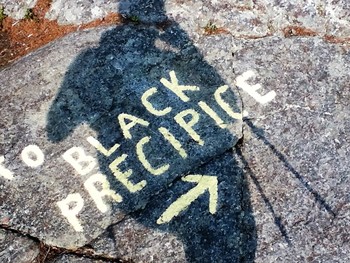
I settle against a boulder, take off my boots and gaze north. (Periodic boot removal, I’m told, reduces foot swelling and may help prevent blisters.) Gulp, I finish lunch, including Golden Oreos that are purported to lubricate the lymphatic system. About twenty, mostly young people are scattered about the peak. A couple of shirtless teens – oh, the horror! – are messing around with a telescoping selfie stick. This, you must agree, should be added to the list of items officially prohibited on Mount Monadnock. Firearms, fireworks, dynamite, dogs, Styrofoam coolers, selfie sticks…Jesus H. Christ, guys, I’d gladly take your photo. Just ask. Of course, then they’d have to talk to this old dude and who knows what awfulness might result.
A family of four arrives, starts munching lunch. Then the father tilts his head back and howls like a wolf. Awoooooo…a good one, long and loud. The little boy giggles and giggles into his juice box. The little girl barely looks up from her cell phone. And the mother declares, extra-cheerily, “Well, he did it, Dad said he’d howl like a wolf if we made it up here and he did it.” The family narrator, in real-time. Was it praise or a needle in the side?
The way down is the Smith Summit Trail, named for Scott A. Smith, and there I hear the staccato clack-clack-clack of the Granite Moth (macaria granitata). Not easy to spy, their variegated brown-gray coloring allows them to blend into granite rock faces. The moths barely move, even when I poke around them with my hiking pole. Also on the descent, I make a diversion to visit the Black Precipice. Indeed it’s a tall cliff, terrifying, and the drop to a bed of broken rocks below would surely be fatal. I stay clear of the edge. Then it’s back to Smith’s trail which diverges into Fairy Spring Trail which brings me, beautifully, to Fairy Spring. This place is the very antithesis of the Black Precipice: a kindly, shaded respite from heat and anxiety; a brook so babbling, so soothing, it should instruct other brooks; and thick moss flowing over rocks, roots and rotting leaves. The gentle afternoon sun filtering through.
I sit, try to clear my head. And wait. A half hour of hiking remains, but let’s end here with the sitting, and the head clearing, and the eternal waiting for fairies.
A family of four arrives, starts munching lunch. Then the father tilts his head back and howls like a wolf. Awoooooo…a good one, long and loud. The little boy giggles and giggles into his juice box. The little girl barely looks up from her cell phone. And the mother declares, extra-cheerily, “Well, he did it, Dad said he’d howl like a wolf if we made it up here and he did it.” The family narrator, in real-time. Was it praise or a needle in the side?
The way down is the Smith Summit Trail, named for Scott A. Smith, and there I hear the staccato clack-clack-clack of the Granite Moth (macaria granitata). Not easy to spy, their variegated brown-gray coloring allows them to blend into granite rock faces. The moths barely move, even when I poke around them with my hiking pole. Also on the descent, I make a diversion to visit the Black Precipice. Indeed it’s a tall cliff, terrifying, and the drop to a bed of broken rocks below would surely be fatal. I stay clear of the edge. Then it’s back to Smith’s trail which diverges into Fairy Spring Trail which brings me, beautifully, to Fairy Spring. This place is the very antithesis of the Black Precipice: a kindly, shaded respite from heat and anxiety; a brook so babbling, so soothing, it should instruct other brooks; and thick moss flowing over rocks, roots and rotting leaves. The gentle afternoon sun filtering through.
I sit, try to clear my head. And wait. A half hour of hiking remains, but let’s end here with the sitting, and the head clearing, and the eternal waiting for fairies.
 RSS Feed
RSS Feed